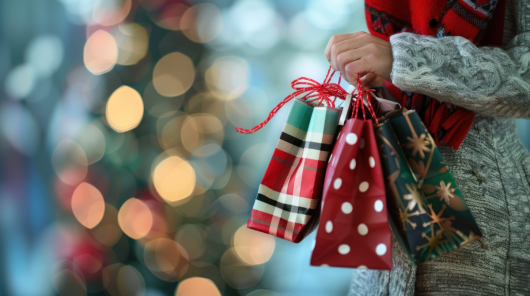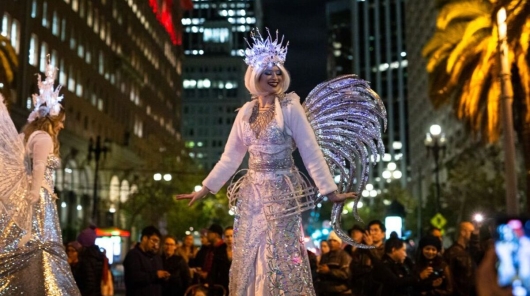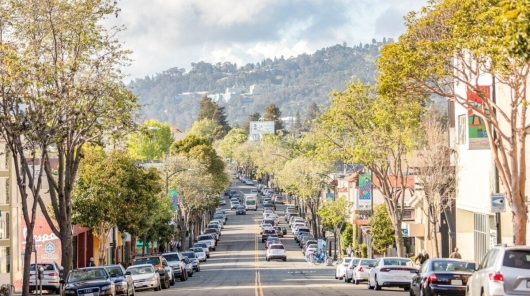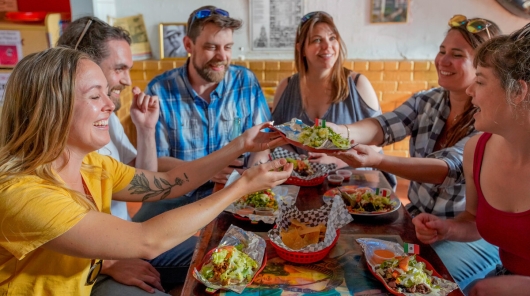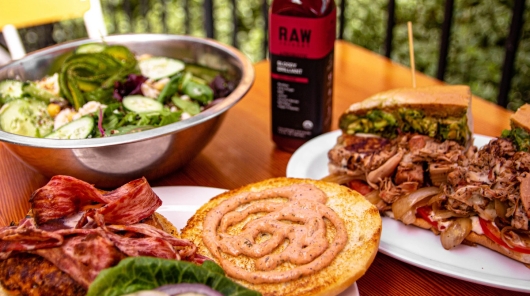
BARTable Walk: Downtown Berkeley to Rockridge
When:
Enjoy on a nice day
Where:
2160 Shattuck Ave.
Berkeley, CA 94704
United States
BART Station:
Downtown BerkeleyWalk Time:
2.5 hoursFollow in the footsteps of Nobel laureates, industry innovators and political activists with a stroll through the Cal campus and then treat yourself to a scoop of “churned-to-order” ice cream on this BARTable walk from Downtown Berkeley to Rockridge in Oakland.
Walk Time: 1.75 hours | Distance: 3.5 miles | Terrain: Sidewalks, paved trails
Exit the Downtown Berkeley Station (use Exit B3) up to Shattuck Avenue and into the new Berkeley BART Plaza that opened in October 2018. The completely reimagined space welcomes the public with café seating, art installations, lighting and sound systems and a live music stage. During the week, top off your travel mug with your favorite brew at the 1951 Coffee BART Kiosk (Monday to Friday, 7am to 2pm) and on weekends, fill up your grocery tote with locally-grown produce and farm-prepped foods at the Ecology Center Berkeley Farmers’ Market (Saturday, 10am to 3pm).
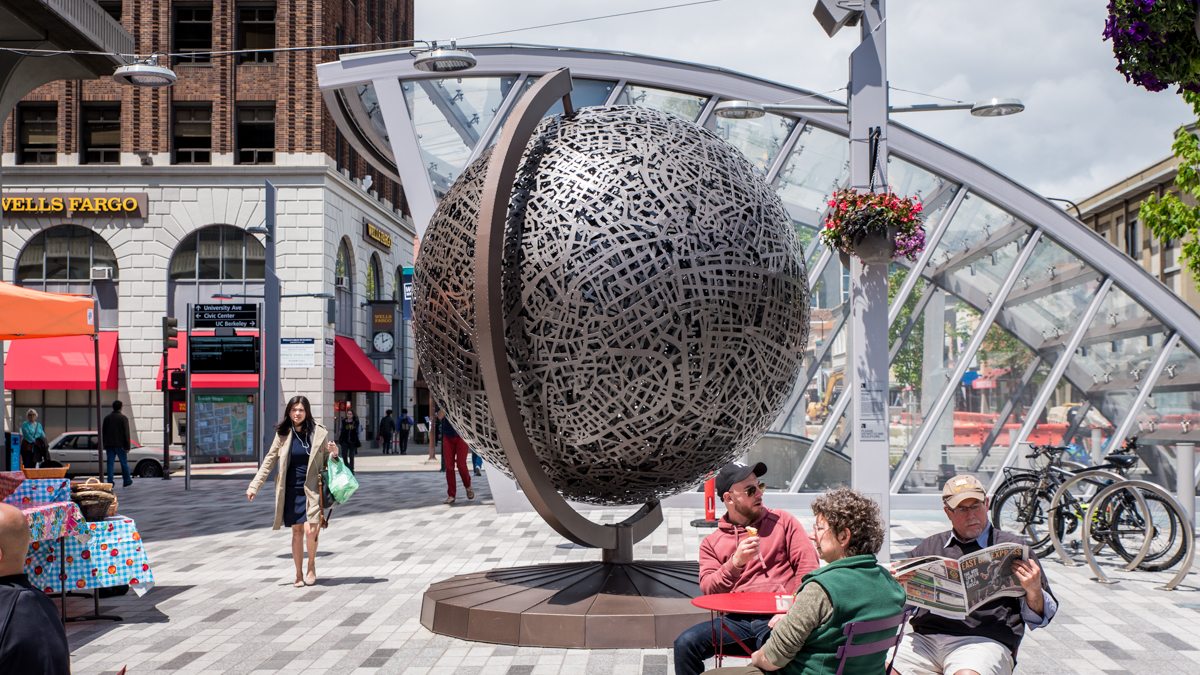
A rotation of public art is planned for the Berkeley BART plaza. First up is the sculpture, “Home,” a 14-foot tall metal globe that Berkeley artist Michael Christian originally made for Burning Man.
Cross Shattuck Avenue and head up Center Street to the University of California, Berkeley campus. Instead of running down a list of well-known facts about the university, let’s go for a few offbeat ones.
- There are 900 feet of tunnels that extend from the northeast corner of campus into the Hayward Fault. They were built by Berkeley mining students during the early 1900s.
- A dog named Igor Fetch received a sociology degree in the early 1970s. He was the housedog and mascot of Bowles Hall. The residents would register him for classes and take his exams.
- There are parking spots on campus reserved for the university’s Nobel Prize winners. Look out for signs marked with “Reserved For NL/Special Permit Required At All Times” (NL=Nobel Laureate).
For more fun facts (and myths), check out this SFGate article, “Hidden Secrets and Legends on the UC Berkeley Campus.”
Continue straight onto the Grinnell Pathway that runs alongside Strawberry Creek as it flows through campus on to the bay. The creek is central to the area’s human history from the indigenous Huchiun Ohlone who depended on it for food and water to the Spanish and Mexican ranchers who drew on it for their grazing cattle to down-and-out Gold Rush miners who settled in the areas around it. It was also the university’s first source of surface water and today, its babble is a backdrop to the students rushing from lecture to lecture.
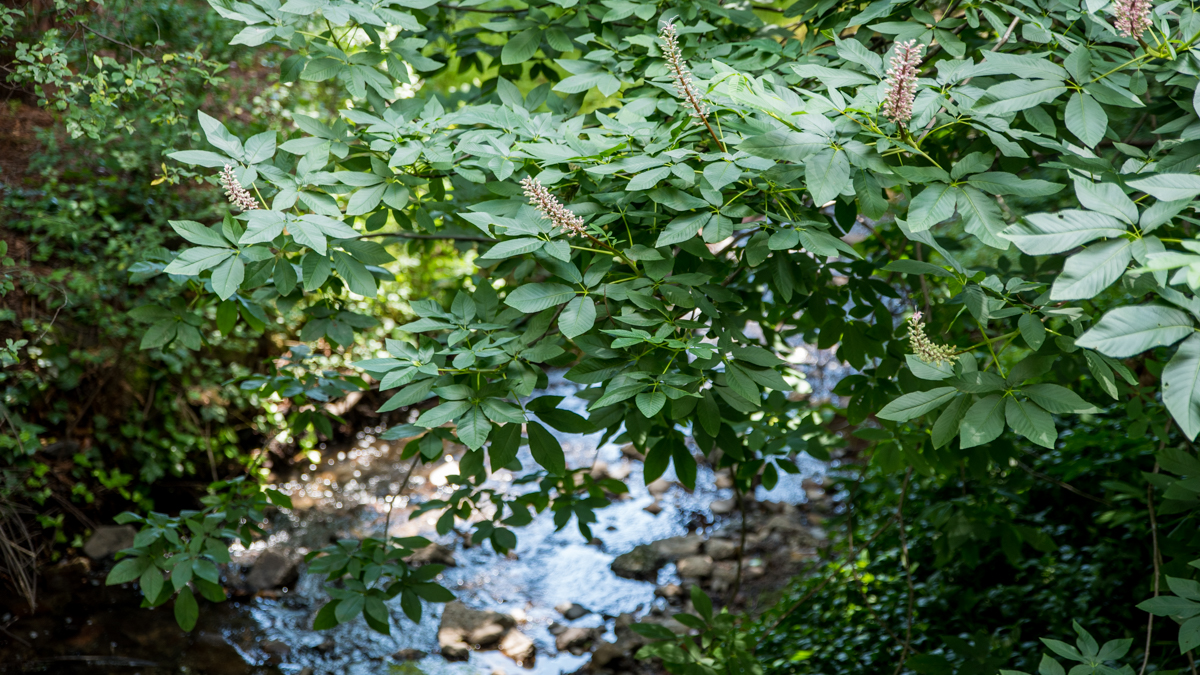
Though much of Strawberry Creek has been culverted over the years, it flows largely open to daylight all the way through campus.
Cross the bridge over Strawberry Creek to the statue, "Football Players," by sculptor Douglas Tilden. It was awarded to the university by San Francisco Mayor James Phelan for winning his challenge made in 1898 to the first team, Cal or Stanford, to win two consecutive Big Games.
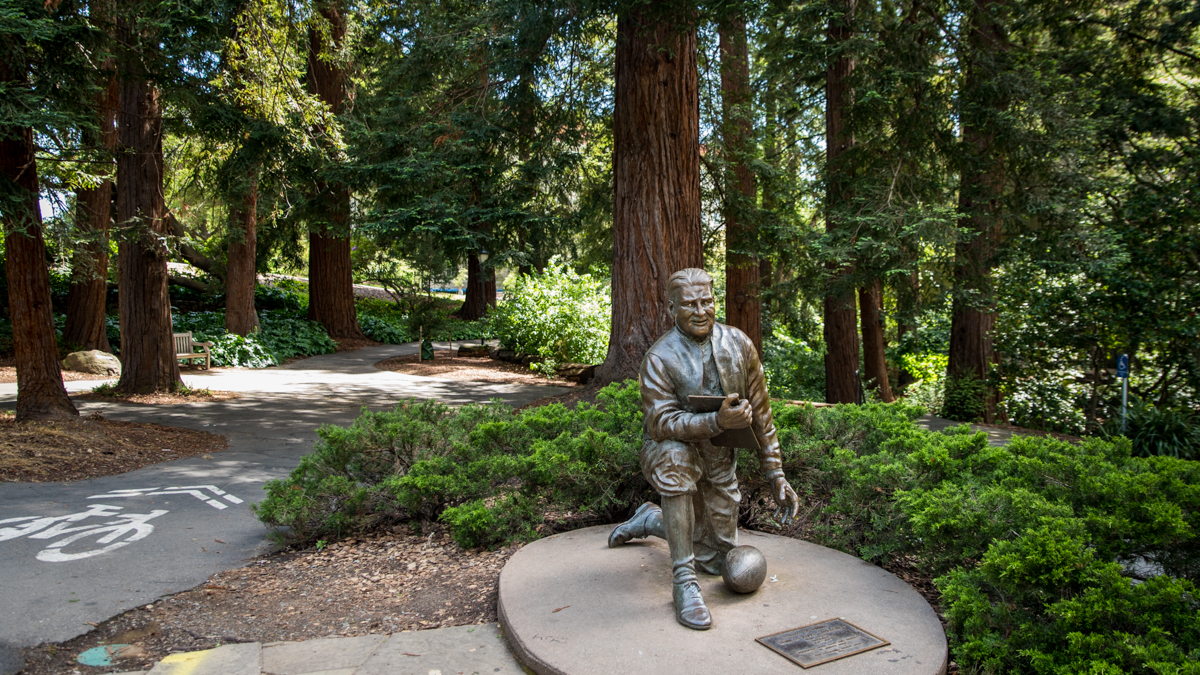
A statue of Lynn "Pappy" Waldorf on the UC Berkeley campus.
Veer left to the Valley Life Sciences Building and follow Campanile Way straight up to Cal’s arguably most iconic landmark, Sather Tower, better known as the “Campanile” for its resemblance to the one on St. Mark’s Square in Venice. It was designed by university supervising architect John Galen Howard and named for early university donor Jane Sather who footed the $250,000 bill. Completed in 1914, it stands at 307 feet, placing it third on the list of the world’s tallest bell and clock towers. An elevator ride to the observation platform is a must. On the way up, know that you’re passing 20 tons of fossils from the University’s Museum of Paleontology stored within the walls. Among the objects, mainly from the La Brea Tar Pits in Los Angeles, are remains of the Smilodon, a gigantic saber-toothed cat. The tower is open Monday to Friday, 10am to 3:45pm; Saturday, 10am to 4:45pm; Sunday, 10am to 1:30pm and 3 to 4:45pm. $4 general admission).
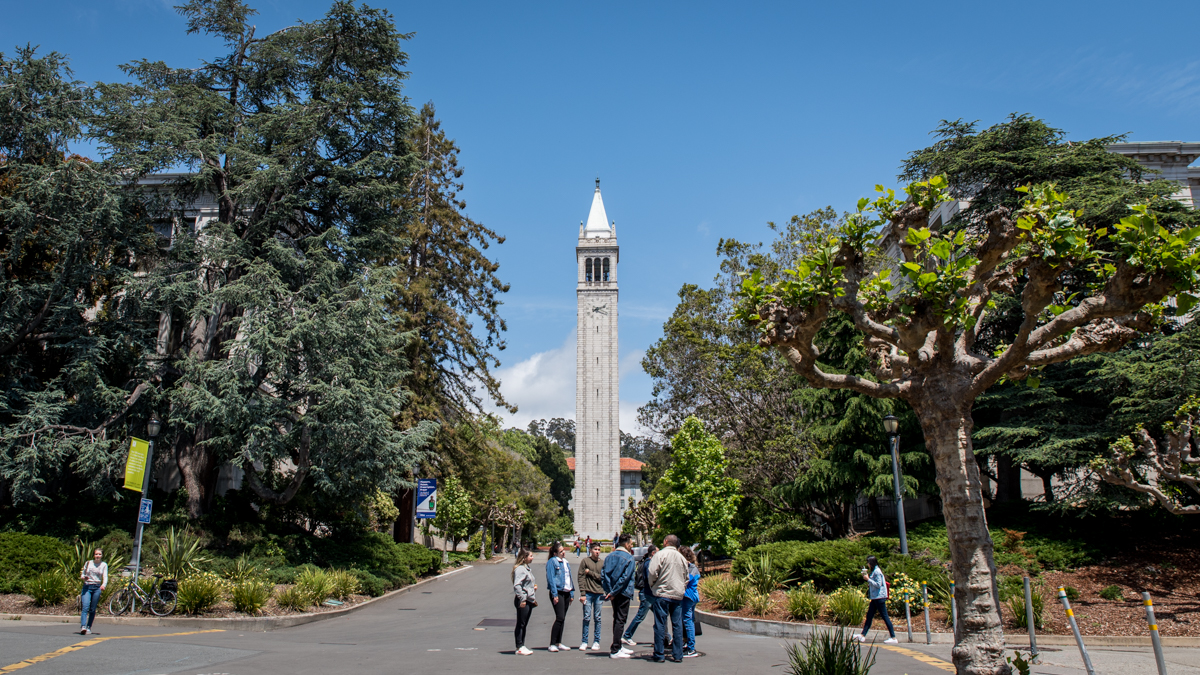
Take in a breath-taking 360-degree view from the observation platform of the Campanile. Joining you may be the Peregrine falcon couple who have nested on the tower for the last few years.
Head away from the Campanile to the south (the side opposite the entrance) along Carillon Road and down the steps by Stephens Hall to the Faculty Glade. The tranquil expanse of open grass, ringed with oaks, redwoods and maples, is a hot spot for sports, sunbathing, picnicking and maybe some studying on sunny days. The area is also thought to have been the site of a Huchiun Ohlone settlement that got water and fished from Strawberry Creek. The slope in the middle of the Faculty Glade is known as 4.0 Hill to students for their tradition of rolling down it to guarantee a 4.0 GPA for the semester.
Turn left and at the north end of the glade, take another left onto the rampway and step into the Faculty Club. Initially designed by local architect Bernard Maybeck, it opened in 1902 and is internationally recognized as a fine example of the American Craftsmen style. The building includes a hotel (the only one on campus) and although the guest rooms are open only to faculty, staff, alumni and members of the campus community, the public can drop in for meals during the week. The Great Hall or the Kerr Deck is a beautiful setting for a mid-walk lunch break. (Monday to Friday: Breakfast, 7:30 to 10am; Lunch 11:30am to 1:30pm, Dinner 5 to 8:30pm).

With its dark woods, carved beams, stained glass and Mission-style furniture, the Faculty Club oozes with arts and crafts style that makes it a lovely venue for weddings and special events.
Return to the glade and continue clockwise on the footpath to another sports statue – this one of beloved football coach, Lynn “Pappy” Waldorf, who saw the Golden Bears to three consecutive Rose Bowls during his tenure (1947 to 1956). In 1994, the Pappy’s Boys alumni group of his former players commissioned the life-size statue and it’s now a ritual stop for Cal football fans on their way up to Memorial Stadium on game days.
Continue down to the left of the statue on Eshleman Road to Sather Gate, Cal’s other most iconic landmark. Completed in 1910, it was also designed by John Galen Howard and also donated by Jane Sather to (also) honor her late husband, Peder Sather. The gate was the original endpoint of Telegraph Avenue and marked the south entrance to campus before the University expanded out to Bancroft Avenue. The eight panels of figures at the top have a storied past. Initially, Sather supported the figures against complaints from students, apparently embarrassed by the nudity. After a time, she changed her mind and ordered them to be taken down. They were lost for 60-plus years until two were discovered under the bleachers at Edwards Stadium in 1977. A few weeks later, the rest were found at a marble company near Mountain View Cemetery in Oakland. However, it wasn’t until two years later, in 1979, that the panels were put back up.
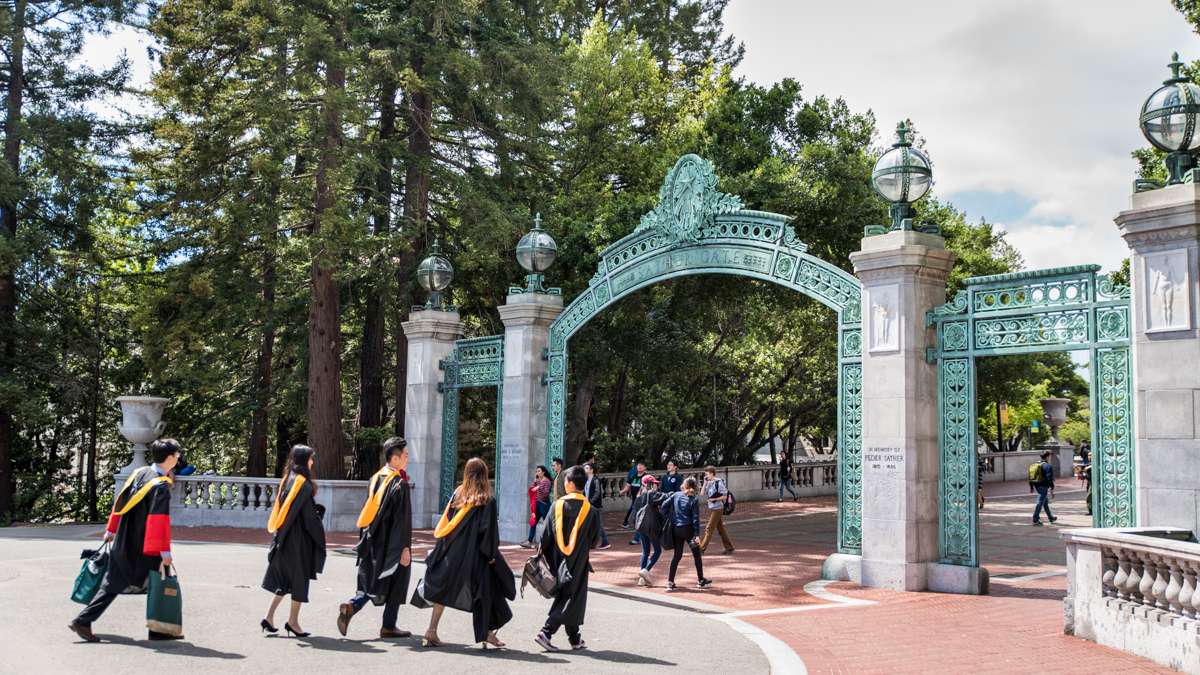
Sather Gate is in the photo sets of most campus visitors. One of its most famous shots is from the Free Speech Movement of students walking through it carrying their Free Speech banner.
Take a left and walk away from Sather Gate through Sproul Plaza and cross Bancroft Avenue into the Southside neighborhood. With its high concentration of student housing, budget-friendly eateries, eclectic shops and street vendors as well as for its location next to campus, the neighborhood has been closely tied to the university.
Keep straight along fabled Telegraph Avenue – its name inseparable from the counterculture and Free Speech movements of the 1960s, a time marked by anti-war demonstrations, clashes between student protesters and police and impassioned calls for free speech, including Mario Savio’s famous "Bodies upon the Gears" speech in December 1964.
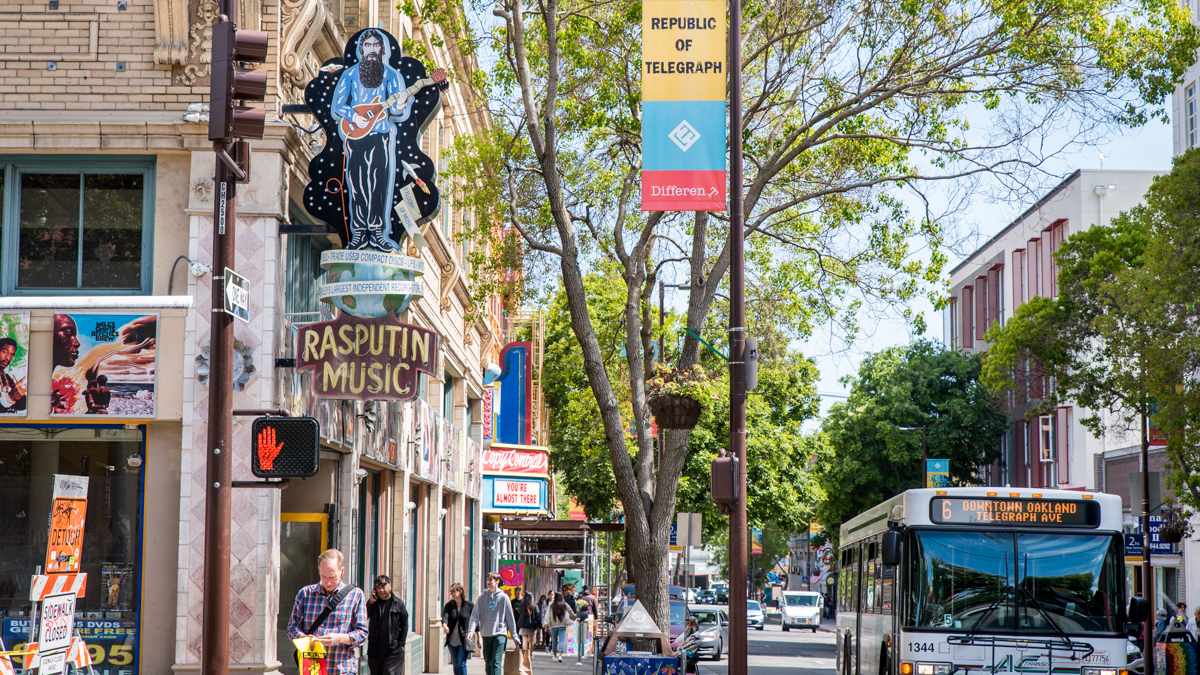
The atmosphere along Telegraph Avenue has cooled down since the 1960s and 70s, but it remains a hub of student and visitor activity along its last 5 blocks leading up to campus.
Take a left onto Haste Street to People’s Park, the plot of land that cemented Telegraph Avenue’s place in the history books. In April 1969, students and residents took over the empty lot owned by the university that had been left undeveloped and become a neighborhood eyesore. They planted trees, flowers and shrubs and turned it into a public park, the “People’s Park,” that would also serve as a space for free speech. On May 15, Alameda County sheriffs and Berkeley police officers were called in to clear out the land and a clash with protestors ensued. Rocks and bottles were thrown at the officers who returned with tear gas and fired buckshot shells at the crowd. Dozens were injured and one student, James Rector, died. The day became known as “Bloody Thursday.” The National Guard was sent in to assist and restore order. On May 30, the city issued a permit for a peaceful demonstration in support of the park, which was eventually reestablished, albeit with a somewhat tenuous status throughout the years.

The People’s Park Mural on Haste Street, by local artists O'Brien Thiele and Osha Neumann, depicts scenes of the “Bloody Thursday” conflict and the Free Speech Movement.
Continue up Haste Street and take a right onto Bowditch Street. Cross over Dwight Way and take a quick right and left to head down Hillegass Avenue (you can also cut directly through the park). Keep straight for several blocks past the mix of classic brown shingle homes, bungalows and apartment buildings to Russell Street. Take a left and then a right onto College Avenue into the heart of the Elmwood District. The two-block commercial strip is lined with shops selling specialty items from books and toys to chocolates and hats. There are also a couple of cafes, a bakery and numerous restaurants. The Elmwood Theater made news in December 2014 when the state’s safety and health division (Cal/OSHA) barred its workers from changing the marquee (citing safety conditions). The sign remained frozen for the next 19 months with the movies Gone Girl, Nightcrawler, The Babadook and Boyhood until July 2016 when it was finally updated with a general message instead of the current showings.

The Elmwood Theater, built in 1914 as the Strand Theater in the Art Deco style, was one of the first buildings in the Elmwood neighborhood.
Keep straight on College Avenue and cross Alcatraz Avenue into Oakland’s Rockridge neighborhood with even more specialty stores, loungey cafes and lively bars and restaurants. Before finishing up the walk at the Rockridge Station just after Miles Avenue, be sure to stop by Smitten Ice Cream and claim your frozen reward. Yes, they do make your order from scratch, using liquid nitrogen to flash freeze it in their specially designed machines. (Monday to Wednesday; noon to 10pm; Thursday, noon to 10:30pm; Friday and Saturday, noon to 11pm; Sunday, noon to 10:30pm).
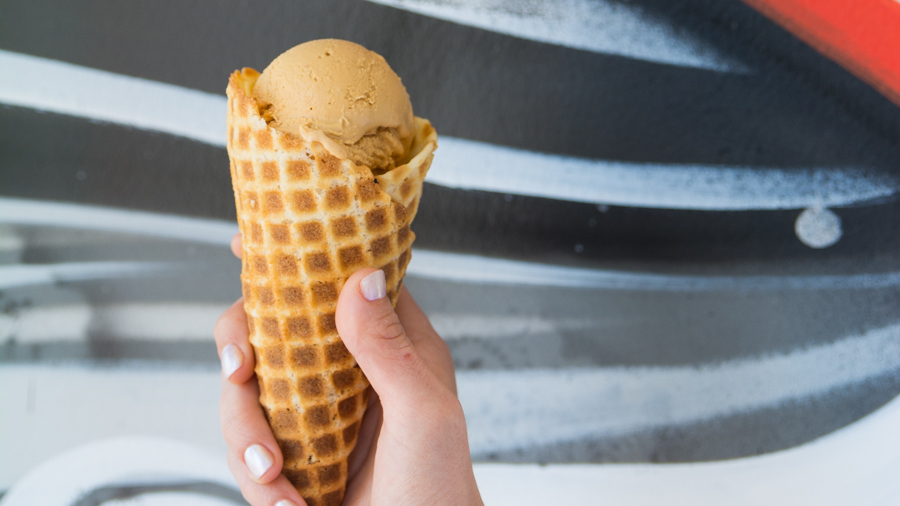
Robyn Sue Fisher started making Smitten Ice Cream in San Francisco out of a toy wagon with a machine powered by a motorcycle battery.
Route Map
Variations and options
- Extend the walk: Start with BARTable Walk: El Cerrito Plaza to Downtown Berkeley and/or continue/end with BARTable Walk: Rockridge to 19th Street Oakland.
- Take a walking tour: UC Berkeley offers a wide variety of campus tours, including free guided and self-guided options. Take a deep dive into the history of Telegraph Avenue and download the Telegraph Berkeley Tour app, developed by the UC Berkeley Graduate School of Journalism. For more ice cream delights, sign up for Local Food Adventure’s Rockridge Ice Cream & Gelato Tour. They also offer a Rockridge food tour.
- Hang around: There’s plenty to explore in Rockridge.
What to bring: Sturdy walking shoes and a daypack with water, bag lunch or snacks (or pick up along the way), sun protection (hat, sunscreen), extra layers or rain gear (just in case). A smartphone is handy for maps and looking up info or taking photos. And, of course, your Clipper card!
About the stations
Downtown Berkeley Station opened in January 1973. It is one of three stations in Berkeley (the others being Ashby and North Berkeley). Located just one block from the University of California campus, a significant number of passengers are Cal students, faculty and staff. With the redevelopment of the main entrance and plaza completed, plans are underway to thoroughly modernize and upgrade the underground station itself.
Rockridge Station first opened in May 1973 and is situated in the center of the Rockridge district along the median of Highway 24. It also straddles the area’s main thoroughfare, College Avenue, with a footbridge connecting the main station facilities to a west entrance and parking lot. From the elevated platform for the Antioch and SFIA/Millbrae lines are views of the East Bay hills on one end and on the other, San Francisco.

